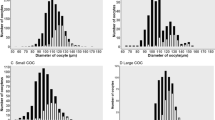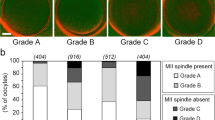Purpose
A majority of in vitro fertilization (IVF) programs continues to evaluate oocyte maturity on the basis of cumulus-coronal morphology (CCM) even though marked asynchrony has been reported between CCM and nuclear maturity. This study was designed to examine changes in embryologists' ability to correctly predict nuclear maturity from CCM as a function of increasing experience. Nuclear maturity was assessed by inverted microscopy with a modified spreading technique at follicular aspiration. A second objective was to determine the percentage of oocytes which displayed asynchrony between CCM and nuclear maturity as assessed by embryologists with extensive experience in oocyte maturity evaluation.
Results
The three participating embryologists had directly evaluated 1304, 75, and 0 oocytes for nuclear maturity and CCM at study initiation and correctly predicted nuclear maturity from CCM in 74, 64, and 47% of oocytes, respectively. Embryologist 1 did not significantly change in predictive ability during the 17-month study period. Embryologist 2 significantly improved in predictive ability during the first 9 months of the study (841 oocytes evaluated) and plateaued thereafter, at a similar percentage of correct predictions as embryologist 1. Embryologist 3 continued to improve in predictive ability throughout the study period, reaching 61% correct predictions at the close of the study after evaluating 223 oocytes. Once embryologists had plateaued in their predictive ability, 72% of oocytes evaluated received the correct nuclear maturity classification based on CCM. Significantly fewer oocytes (54%; 375/690) evaluated by embryologists who had not plateaued in their predictive ability received the correct nuclear maturity classification based on CCM.
Conclusions
These results indicate that embryologists' ability to predict oocyte nuclear maturity correctly from CCM continues to change over several months even when pretraining video recordings are used before beginning direct evaluations. After embryologists plateaued in their predictive ability, nuclear maturity still could not be correctly predicted from CCM in 28% of oocytes due to asynchrony between nuclear and CCM maturity. Based upon this, circumstances in which the spreading technique should be used for direct assessment of nuclear maturity as opposed to assessment of CCM only are discussed.
Similar content being viewed by others
References
Laufer N, Tarlatzis BC, DeCherney AH, Masters JT, Haseltine FP, MacLusky N, Naftolin F: Asynchrony between human cumulus-corona cell complex and oocyte maturation after human menopausal gonadotropin treatment for in vitro fertilization. Fertil Steril 1984;42:366–372
Veeck IL: Oocyte assessment and biological performance. Ann NY Acad Sci 1988;541:259–262
Trounson AO, Mohr LR, Wood C, Leeton JF: Effect of delayed insemination on in-vitro fertilization, culture and transfer of human embryos. J Reprod Fert 1982;64:285–294
Veeck IL: Morphological estimation of mature oocytes and their preparation for insemination.In In Vitro Fertilization, HW Jones Jr, GS Jones, GD Hodgen, Z Rosenwaks (eds). Norfolk, VA, 1986 p 81
Marrs RP, Saito H, Yee B, Sato F, Brown J: Effect of variation of in vitro culture techniques upon oocyte fertilization and embryo development in human in vitro fertilization procedures. Fertil Steril 1984;41:519–523
Schmiady H, Kentenich H: Premature chromosome condensation after in-vitro fertilization. Hum Reprod 1989;4:689–695
Badenas J, Santalo J, Calafell JM, Estop AM, Egozcue J: Effect of the degree of maturation of mouse oocytes at fertilization: A source of chromosome imbalance. Gamete Res 1989;24:205–218
Zenzes MT, de Geyter C, Bordt J, Schneider HPG, Nieschlag E: Abnormalities of sperm chromosome condensation in the cytoplasm of immature human oocytes. Hum Reprod 1990;5:842–846
Tarin JJ, Pellicer A: Consequences of high ovarian response to gonadotropins: A cytogenetic analysis of unfertilized human oocytes. Fertil Steril 1990;54:665–670
Balakier H, Casper RF: A morphologic study of unfertilized oocytes and abnormal embryos in human in vitro fertilization. J Vitro Fert Embryo Transfer 1991;8:73–79
Pieters MHEC, Dumoulin JCM, Engelhart CM, Bras M, Evers JLH, Graedts JPM: Immaturity and aneuploidy in human oocytes after different stimulation protocols. Fertil Steril 1991;56:306–310
Sundstrom P, Nilsson BO: Meiotic and cytoplasmic maturation of oocytes collected in stimulated cycles is asynchronous. Hum Reprod 1988;3:613–619
Bomsel-Helmreich O, Huyen LVN, Durand-Gasselin I, Salat-Baroux J, Antoine JM: Timing of nuclear maturation and cumulus dissociation in human oocytes stimulated with clomiphene citrate, human menopausal gonadotropin, and human chorionic gonadotropin. Fertil Steril 1987;48:586–595
Testart J, Frydman R, De Mouzon J, Lassalle B, Belaisch JC: A study of factors affecting the success of human fertilization in vitro. I. Influence of ovarian stimulation upon the number and condition of oocytes collected. Biol Reprod 1983;28:415–424
Plachot M, Mandelbaum J: Oocyte maturation, fertilization and embryonic growth in vitro. Br Med Bull 1990;46:675–694
Tarlatzis BC, Laufer N, DeCherney AH, Polan ML, Haseltine FP, Behrman HR: Adenosine 3′,5′-monophosphate levels in human follicular fluid: relationship to oocyte maturation and achievement of pregnancy after in vitro fertilization. J Clin Endocrinol Metab 1985;60:1111–1115
Tsuji K, Sowa M, Nakano R: Relationship between human oocyte maturation and different follicular sizes. Biol Reprod 1985;32:413–417
Mahadevan MM, Fleetham J: Relationship of a human oocyte scoring system to oocyte maturity and fertilizing capacity. Int J Fertil 1990;35:240–244
Daya S, Kohut J, Gunby J, Younglai E: Influence of blood clots in the cumulus complex on oocyte fertilization and cleavage. Hum Reprod 1990;5:744–746
Vanluchene E, Hinting A, Dhont M, DeSutter P, Van Maele G, Vanderkerckhove D: Follicular fluid steroid levels in relation to oocyte maturity and in vitro fertilization. J Steroid Biochem Mol Biol 1991;38:83–87
Bar-Ami S, Gitay-Goren H, Brandes JM: Different morphological and steroidogenic patterns in oocyte/cumulus-corona cell complexes aspirated at in vitro fertilization. Biol Reprod 1989;41:761–770
Thanki KH, Schmidt CL: Follicular development and oocyte maturation after stimulation with gonadotropins versus leuprolide acetate/gonadotropins during in vitro fertilization. Fertil Steril 1990;54:656–660
Tarlatzis BC: Oocyte collection and quality. Assist Reprod Rev 1992;2:16–22
Hammitt DG, Syrop CH, Hahn SJ, Walker DL, Butkowski CR, Donovan JF: Comparison of concurrent pregnancy rates for in-vitro fertilization-embryo transfer, pronuclear stage embryo transfer and gamete intra-fallopian transfer. Hum Reprod 1990;5:947–954
Veeck LL:In Extracorporeal Maturation, Norfolk. Ann NY Acad Sci, 1984, pp 357–367
Leung CKM, Leong MKH, Chan YM, Wong CJY, Chan HHY, Tucker MJ: Fallopian replacement of eggs with delayed intrauterine insemination (FREDI): An alternative to gamete intrafallopian transfer (GIFT). J Vitro Fert Embryo Transfer 1989;6:129–133
Das K, Stout LE, Hensleigh HC, Tagatz GE, Phipps WR, Leung BS: Direct positive effect of epidermal growth factor on the cytoplasmic maturation of mouse and human oocytes. Fertil Steril 1991;55:1000–1004
Cha KY, Koo JJ, Ko JJ, Choi DH, Han SY, Yoon TK: Pregnancy after in vitro fertilization of human follicular oocytes collected from nonstimulated cycles, their culture in vitro and their transfer in a donor oocyte program. Fertil Steril 1991;55:109–113
Dandekar PV, Martin MC, Glass RH: Maturation of immature oocytes by coculture with granulosa cells. Fertil Steril 1991;55:95–99
Medical Research International and Society for Assisted Reproductive Technology: In vitro fertilization-embryo transfer in the United States: 1990 results from the IVF-ET registry. Fertil Steril 1992;57:15–24
Author information
Authors and Affiliations
Rights and permissions
About this article
Cite this article
Hammitt, D.G., Syrop, C.H., Van Voorhis, B.J. et al. Prediction of nuclear maturity from cumulus-coronal morphology: Influence of embryologist experience. J Assist Reprod Genet 9, 439–446 (1992). https://doi.org/10.1007/BF01204049
Received:
Accepted:
Issue Date:
DOI: https://doi.org/10.1007/BF01204049




